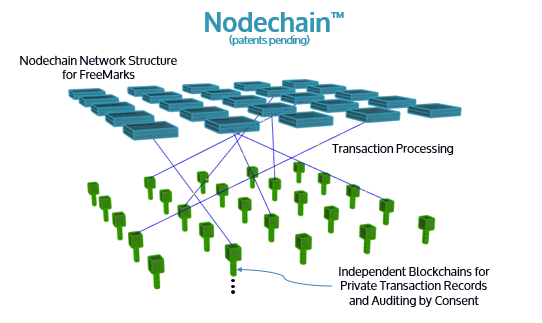The Nodechain
The foundation of a better engineered cryptocurrency
As discussed elsewhere, humans have used coins as transactions for thousands of years. Central to the functionality of a coin’s use is the concept of ownership: making ownership the central idea of a software data-structure is the distinction that the patent-pending Nodechain brings to the cryptocurrency industry.
Nodechain stands for No Data Chain, and its use produces a many-magnitude increase in processing speed (capable of literally hundreds of millions of transactions per second, with a massively parallel architecture), greater privacy and much less energy requirements for transaction processing.
Nodechain vs Blockchain
[slide-anything id=”253″]
How is the Nodechain different than the Blockchain?
The other primary technology, blockchain, uses transactions as the central idea of cryptocurrency. This too was novel, but not practical because of the huge data storage requirements. For instance, if one day blockchain technology was used for the transactions for many billions of people, all that data would have to be stored globally, with very little of it useful. Transaction data is the basis of blockchain validity. Clipping it off, as is being done with SegWit, also known as Lightning technology, may reduce this storage requirement, but undermines the integrity of the blockchain concept.
This Nodechain is much more secure, and completely private, but usable by anyone. Instead of a ledger of transactions, the Nodechain keeps a list of FreeMarks and their owners, but distributed randomly on every member of a network, not just some nodes. Distributed authority, called Digital Prerogative, is allocated more equally over the network than in systems like Bitcoin.
That’s right, the Nodechain is a more egalitarian technology than the blockchain, as discussed more thoroughly in the White Paper.
One file contains a list of all FreeMarks and their owners. This file is broken-up and redundantly spread amongst all the nodes in the network. This means that the file has a relatively constant and tiny file size (about 1 MB) no matter how big the network grows.
No one knows where a particular FreeMark, with a list of its owner and prior owners, is stored because its address is a function of the hash pointer.
Any node in the network can do a transaction with any FreeMark it owns, sharing the processing with the other party in the transaction and the remote node storing the information, verifying that both parties consent. The address is locked when accessed, and the transaction can occur independently of the rest of the system, allowing massively parallel processing on a time-scale reasonable for every participant.
Why is the Nodechain better than the Blockchain?
Another big advantage of the Nodechain technology is that Bitcoins/blockchain tokens do not all have unique identities and this is why a fundamentally different solution is important. Worldfree’s solution is similar to physical cash—we can confirm that it has not been used if the owner still has it. If a person no longer does, then it has been spent. This concept is established digitally, and makes all the difference.
The Nodechain, because it removes all the data about transactions off the public networks, is much more secure, and much more scalable by original design, not just as an afterthought correction to the initial concept.
The Nodechain uses parts of the Blockchain
The Nodechain actually also uses the blockchain, but only on each individual’s system. In this way, the FreeMark keeps the best part of the blockchain, which is its immutable transaction record, but takes it out of the public network.
This is a genuine innovation in the cryptocurrency space. Recognising the value of the blockchain, but only as a part of a general solution to the challenge and opportunity of digital currencies.
The picture below shows how the Nodechain actually utilises the Blockchain, but only as a subsidiary role, for its primary advantage, without its security and scalability disadvantages.

The Nodechain makes the FreeMark a Better Digicurrency
On the forthcoming Worldfree Network you will be able to tokenize any asset you would like—bonds, your own equities, and novel asset baskets—without programming and trade them globally. You will be able to buy and sell these as well as physical assets with FreeMarks that keep their value—both inflation proof and deflation proof. Other cryptocurrencies are not good enough to do this—their prices are too unstable and will discourage the business of exchange generally.
Worldfree is simply a better place to do business, all accessed through the world’s most advanced natural language reasoning technology, which has already matured commercially.
